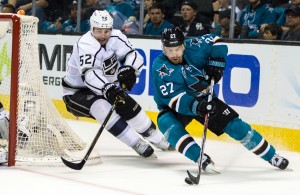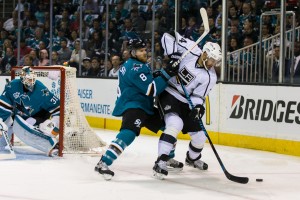Commentators have speculated the Los Angeles Kings’ puck-possession style is out-of-date. Others say they’re too big, too slow and too defensive.
In part one of this article, I talked about the Kings’ vulnerability to the penalty kill and how their high number of penalties contradict their puck-possession identity. How can they generate scoring opportunities when they’re busy killing penalties? What good is a playmaker if he’s sitting in the penalty box?
Whether or not the Kings can improve an already quality penalty-killing unit, every penalty incurred generates lost scoring opportunities.
Below is a video from March 14, 2013, between the LA Kings and the San Jose Sharks. Here, San Jose’s Andrew Desjardins nails Colin Fraser behind the Kings’ net. Jake Muzzin then showed Desjardin his unappreciation for the hit in an honorable effort to stand up for his teammate:
As a result, five penalties were handed out, four of them assigned to the Kings:
- 05:59 SJS Andrew Desjardins: Fighting – five minutes (Jake Muzzin)
- 05:59 LAK Jake Muzzin: Fighting – five minutes (Andrew Desjardins)
- 05:59 LAK Jake Muzzin (served by Jordan Nolan): Instigator, Face Shield – two minutes (Andrew Desjardins)
- 05:59 LAK Jake Muzzin (served by Jordan Nolan): Unsportsmanlike conduct – two minutes
- 05:59 LAK Jake Muzzin: Misconduct – 10 minutes (Andrew Desjardins).
The fight turned out to be quite costly for Los Angeles and unfortunately, scenarios such as this one are all too common. But hey, at least San Jose knows what to expect when they drill someone behind the net. Was this fight really worth it for the Kings, though? I admit some penalties are worthwhile, but I don’t think this one was.
The Use of Advanced Analytics
The rising trend of advanced analytics is providing more and more ways to understand hockey systems. Among the plethora of data, there may be a way to gain insight into the Kings’ efficiency and perhaps a way to reduce penalty infraction minutes (PIM) with very little effort.

If Los Angeles knew which lineups received fewer penalties, statistically, they could also learn why. If analytics revealed patterns that identified certain players likelihood for increased penalties among linemates, they could potentially create lineups with greater efficiency.
My hypothesis is certain players have an effect on their linemates that sometimes results in increased penalties (even though they don’t accrue many penalties themselves and may not be aware of this effect).
The Kings’ lineup doesn’t switch up too often. Head coach Darryl Sutter tinkered with this throughout each of the five playoff games last season. Tyler Toffoli played alongside a total of five forwards and five defensemen when a teammate received a penalty on the ice with him. Understanding how many or how few penalties a line receives could be a good indicator of effective lineups.
Measuring Linemates’ Penalties
Which lineup is more valuable to the Kings? The one that scores more often than the other or the one that incurs fewer penalties and reduces its total number of odd-man situations? For Los Angeles last spring, fewer penalties to kill would have made all the difference in the world against San Jose.
For the purposes of this article, I’ve used data from the Kings’ five playoff games against the Sharks in 2015-16. It is a small sample size of playoff games, but patterns are still evident, suggesting this may be an effective measurement.

The plus/minus metric is quite useful for evaluating an individual player’s impact on their team. Knowing how many goals are scored, and scored against while a specific player is on the ice, is a good indicator of effectiveness. What if we used this same metric to measure penalties? What if we used plus-one for every penalty the opposition received and minus-one for every penalty a Kings player received?
Theoretically, this metric could reveal players who have a natural inkling to “fire-up” linemates, even though he may not get a substantial number of penalties himself. It could also indicate which players (and even which lineups) are better at drawing penalties on the opposition and preventing linemates from getting penalties. Tanner Pearson, for example, drew the most penalties among the Kings during its five playoff games against San Jose. Coincidence?
This information should be taken into consideration, strategically. If you’re facing a team with a player known for getting frustrated, you could increase your odds of a power play by giving guys with a high ‘plus/minus PIM rate’ regular shifts. With new analytics, teams could identify such players and use this data to increase the probability of a preferred outcome.
The Kings, PIM & Linemates
If we take a look at all the Kings players who received penalties during the 2016 Stanley Cup Playoffs, we’ll see there weren’t any specific players who received a high number of penalties. Of players who did get them, they averaged one to two penalties each. If we look at players whose linemates incurred penalties, however, we’ll start to see some more interesting numbers.

Dwight King skated between 12:31 and 18:15 minutes each of the five games for a total of 72 minutes and only received one penalty. However, a teammate on the ice with him received a penalty every 10-and-a-half minutes:
Game 1, period 1: Vincent Lecavalier (F)
Game 1, period 2: Drew Doughty (D)
Game 3, period 2: Marian Gaborik (F)
Game 4, period 2: Rob Scuderi (D) and Luke Schenn (D)
Game 5, period 1: Luke Schenn
Game 5, period 2: Trevor Lewis (F)
King has the worst linemate-PIM rate on the team. This could indicate several contributing factors in penalties-received, namely switching King around in the lineup increased penalties his linemates received, or, penalties follow him everywhere he goes. The first explanation seems more logical as lineups are constantly being altered, ergo penalties increase because linemates might not be as good at reading each other and mistakes are made.
PIM Influences
Moving players from line to line isn’t the only way penalties can be influenced. Players who get more ice time are bound to have more linemates who incur penalties. There is a correlation between ice time and linemates receiving penalties – more ice time means more linemates with penalties. Jake Muzzin, Drew Doughty, and Rob Scuderi led all players in time on ice during these five games, and consequently, Muzzin and Doughty had the most number of linemates who received penalties.
Forwards with the most time on ice were Anze Kopitar, Jeff Carter, Milan Lucic, Tyler Toffoli, Dustin Brown, Dwight King, and Vincent Lecavalier, in that order. Forwards with the best linemate penalty-per-minute rates were Lecavalier, Toffoli, Kris Versteeg, Carter, Pearson, and Gaborik, in that order. Defensemen with the best linemate penalty-per-minute rates were Brayden McNabb (who actually had the second-best rate on the team) and Scuderi (who had the second-highest total time on ice).
According to this metric, Toffoli, the 47th overall pick in the 2010 NHL Entry Draft, had the lowest linemate penalty-per-minute rate to time on the ice ratio. He played nearly 84 minutes in the Kings’ five playoff games yet a teammate on the ice with him would only receive a penalty every 28 minutes.
http://gty.im/614917858
Whether or not Sutter uses such metrics to calculate the probability of penalties received doesn’t mean he can’t see what’s right in front of him. Perhaps that’s one of the reasons why Kyle Clifford didn’t see more ice time in the playoffs last year. He played a total of 34 playoff minutes with linemates incurring penalties every 11-and-a-half minutes.
Complete Kings Coverage From THW
As we begin the 2016-17 season, we’re seeing new faces in Los Angeles and there are different reasons for each and every one of them. Will Devin Setoguchi exceed expectations and shock the world of hockey? Will Pearson continue to “come out of nowhere” and cement the viability of his 30th overall selection at the 2012 Draft? By January, the Kings will have found its most efficient lineups, hopefully not just in puck possession, but also in their desperate need to reduce overall penalties.